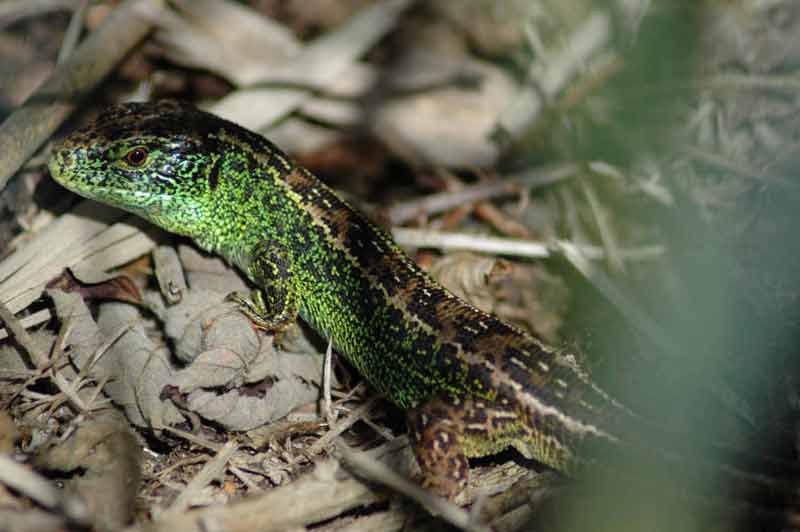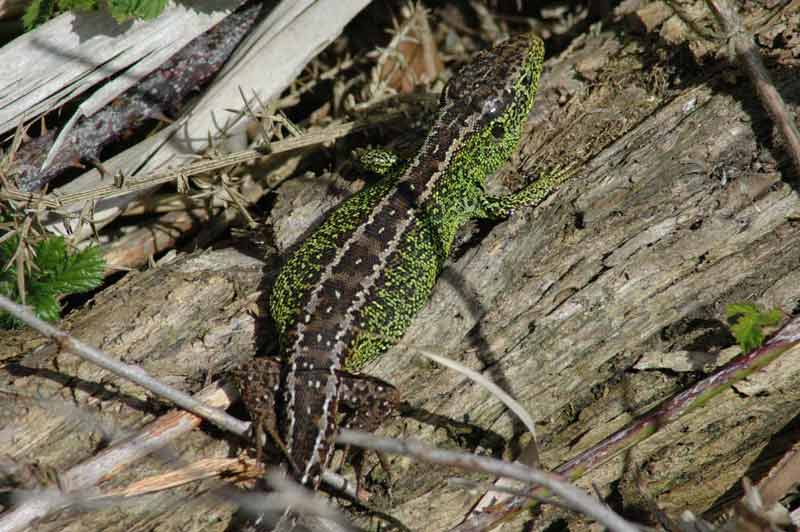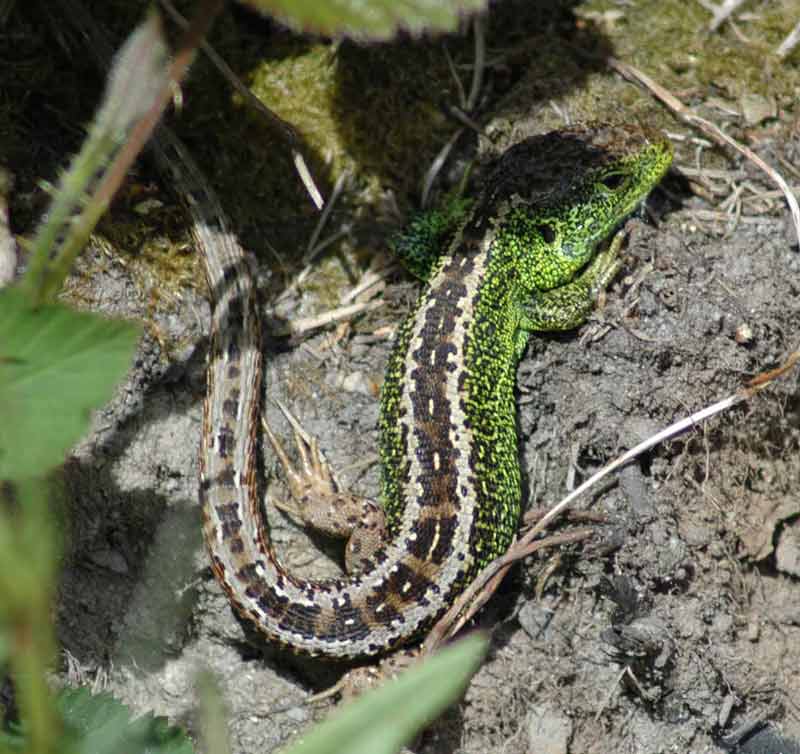 |
 |
Sand lizard markings: |
| Author | Message |
|
Vicar Senior Member Joined: 02 Sep 2004 No. of posts: 1181 View other posts by Vicar |
Posted: 12 Sep 2004 Do the different Sand lizard colonies have slightly different markings ? I only have a small sample set at the moment, but I can see similarities between the Hankley 'Sandies' markings and a different trend with the Frensham ones. Or am I being hoplessley subjective ?
Steve Langham - Chairman 
Surrey Amphibian & Reptile Group (SARG). |
|
Vicar Senior Member Joined: 02 Sep 2004 No. of posts: 1181 View other posts by Vicar |
Posted: 03 May 2005 Right, now have a pretty decent selection of pics of Surrey Heath Sandies, and have even knocked up a format for recording the markings to distinguish individuals. What I now need is a system for characterising the markings, which saves me from checking each old photo against a new pic. Obviously location can be a fliter, but I need something which represents the markings, maybe numerically. This MUST have been done with such things as fingerprints before pattern-matching on modern PCs. Before I re-invent the wheel and create my own system, does anybody know of an extant system in use ? would make far more sense for me to adopt a system than create a new one ! Any help out there ?? Steve Langham - Chairman 
Surrey Amphibian & Reptile Group (SARG). |
|
David Bird Forum Specialist Joined: 17 Feb 2003 No. of posts: 515 View other posts by David Bird |
Posted: 04 May 2005 I have thought in the past that certain areas have specimens with similar types of patterns both in the Snad Lizard and Smooth Snakes (perhaps related ?) but then go there on another day and see some individuals that differ radically whether these are natural variation in the local population or individuals wandering in from other genetically different populations would need a lot more work than I have time to do. Digitisation of the pattern where there are light and dark areas has been done with Great Crested Newt will try to dig out the paper but may not be so easy with the Sand Lizard back pattern, darkness does differ with the time of skin shedding a lot more than on newt bellies. I know it can be a bind having a lot of pics to sort through every time you take another photograph to see if it is another animal. David British Herpetological Society Librarian and member of B.H.S Conservation Committee. Self employed Herpetological Consultant and Field Worker. |
|
Vicar Senior Member Joined: 02 Sep 2004 No. of posts: 1181 View other posts by Vicar |
Posted: 04 May 2005 Thanks for that David, What I am thinking of is developing a system which cues on characteristics of the marking pattern, not exact representation. (Or adopting one if one exists). One example may be; on the back patternation, where there are elements of black banding which connect unbroken between both dorsal stripes, this could be represented as a boolean 1 or 0. There MAY be a way of codifying some aspects of patternation. I shall rely heavily on the expertise of this forum to suggest possible characteristics. Once we have a set of ideas, I can then just apply to the pictures I have to determine feasibility. If it looks hopeful, I'll liaise with Alan here in Surrey, and then maybe expand to see if such a system works with Dorset specimens. Very interested to hear how the Newt characterisation worked out. Thanks for the interest ! Steve Langham - Chairman 
Surrey Amphibian & Reptile Group (SARG). |
|
David Bird Forum Specialist Joined: 17 Feb 2003 No. of posts: 515 View other posts by David Bird |
Posted: 04 May 2005 I have found a 1984 paper that could be useful but it is in German and didnt use computer, it is on the Variability of the patterns of skin markings in the Green Toad Bufo viridis where they mapped out the various markings numbered each and were able to produce a key for the 48 mastertypes they found. How is your German ? The pics may be useful with the markings they used which would obviously have to be changed for Sand Lizard Will scan in the paper anyway David British Herpetological Society Librarian and member of B.H.S Conservation Committee. Self employed Herpetological Consultant and Field Worker. |
|
Vicar Senior Member Joined: 02 Sep 2004 No. of posts: 1181 View other posts by Vicar |
Posted: 05 May 2005 Cheers David, My German is passable, or failing that I'm still in contact with my Austrian Ex. who happens to be a technical translator :P either way I'm sure it would be useful. The email link on my signature should work. I'll keep this thread updated on any progress. Steve Langham - Chairman 
Surrey Amphibian & Reptile Group (SARG). |
|
Vicar Senior Member Joined: 02 Sep 2004 No. of posts: 1181 View other posts by Vicar |
Posted: 11 May 2005 Got a half-decent pic of what I would consider a typical Surrey male sandy, how do the markings compare with Dorset specimens ?
Steve Langham - Chairman 
Surrey Amphibian & Reptile Group (SARG). |
|
David Bird Forum Specialist Joined: 17 Feb 2003 No. of posts: 515 View other posts by David Bird |
Posted: 11 May 2005 Steve, Nice pic, I have attached 3 pics of 3 males seen on Sunday all in a small area about 8 m long on a bank. Close to Poole Harbour in Dorset. I shall try to get a selection of back patterns in a folder and put it on my Yahoo profile at the weekend, will e-mail you when I have done this. David 

 British Herpetological Society Librarian and member of B.H.S Conservation Committee. Self employed Herpetological Consultant and Field Worker. |
|
Alan Hyde Senior Member Joined: 17 Apr 2003 No. of posts: 1416 View other posts by Alan Hyde |
Posted: 12 May 2005 Very Nice pics Steve and David  O-> O+> |
|
Chris G-O Member Joined: 14 May 2003 No. of posts: 36 View other posts by Chris G-O |
Posted: 15 May 2005 Hi Vicar (Steve), I doubt you'll find any differences in patterns between Surrey & Dorset without a massively intensive study with complicated analysis. The only regional differences i'm aware of are the Merseyside race which have very broad dorsolateral silvery grey bands between the lateral and the dorsal markings. However, in ALL British populations there is just so much variation, i cannot see how you'd find a useful distinction. Out of interest, did you end up getting a licence yourself? We were discussing putting you on the HCT one. You sound like you're out a lot. It's important that your results get onto the national database and are put to good use for the conservation of the species. cheers, Chris Chris Gleed-Owen, Research & Monitoring Officer, The HCT & BHS Research Committee Chair |
|
Iowarth Admin Group Joined: 12 Apr 2004 No. of posts: 222 View other posts by Iowarth |
Posted: 30 May 2005 Further to Chris GO's post please see my reply to the (now nearly a year old) topic re races. Although it sets out general principles re the differences between races (and they are pronounced enough so that most of us with experience can identify the race by appearance alone about 70% of the time) I have to agree with Chris re the difficulty in applying a universal rule. It can be no more than guidance. As I said in the post under the topic mentioned:- "Having said this - every variation can be seen in every location. it would appear that the variations occur naturally and a combination of trace minerals in the habitat and natural selection (i.e. which pattern provides the best camouflage) are the determinants as much as the racial genes." Chris Davis, Site Administrator Co-ordinator, Sand Lizard Captive Breeding Programme |
|
Vicar Senior Member Joined: 02 Sep 2004 No. of posts: 1181 View other posts by Vicar |
Posted: 30 May 2005 I was chatting with Emma Hutchings (sp?) from Marwell PT the other day, she mentioned they have somebody looking at the automated recognition of an individual L.a from a scanned pic, they are adapting the method used for Zebras (stripes). Maybe Chris G-O's student knows more?. Assuming they are using a neural-net based system (that's a guess by me), the weightings may give some indication of racial differences. (just a thought). When captive L.as are reintroduced...is stock from the appropriate race used ? Steve Langham - Chairman 
Surrey Amphibian & Reptile Group (SARG). |
|
Iowarth Admin Group Joined: 12 Apr 2004 No. of posts: 222 View other posts by Iowarth |
Posted: 30 May 2005 That does sound interesting. Certainly Sand Lizard markings seem to be as individual as fingerprints and effective as an identification at this level. I am not so sure at race level because all variations can be seen in all races at some time. I doubt if it could improve much on the "expert's" identification. Regarding re-introductions of La, yes, where it is clear what race would have been found in a given area then only the appropriate race is used. For example, Welsh re-intros being thus far restricted to the North & West use the Merseyside race as there is historical contiguity of suitable largely dune habitat. Further South there are areas where it is difficult to decide whether Surrey or Dorset animals are more appropriate but these two races are far more similar to each other anyway. Chris Davis, Site Administrator Co-ordinator, Sand Lizard Captive Breeding Programme |
|
GemmaJF Admin Group Joined: 25 Jan 2003 No. of posts: 2090 View other posts by GemmaJF |
Posted: 08 Mar 2006 Steve, Did you ever come up with a numerical system for keeping up with individuals in reference to your first post in this thread? It seems the concept is much along the lines of the methods used by Benson for adder, see http://www.herpetofauna.co.uk/forum/forum_posts.asp?TID=1365 &PN=1&TPN=1 The idea being that using various features such as head marking, scalation and stripe variation you can code an individual adder. It should then be easier to check previous records to see if this animal has been encountered before, using partial or complete information, rather than checking potentially hundreds of images. I've got a working example BW140206_001_M_MB_P_5152142_FZZMMWTO which translates to site/date first seen_arbitrary field number_sex_base colour (mid brown)_scalation (P = parietal, due to a striking feature)_5152142, relates to scale group counts_FZZMMWTO is after Benson and is a way to describe the stripe, in this case it translates to fore-body zigzag mid-body mirror wave tail ovals underscores are to keep it windows friendly, In theory you could maybe get the FZZMMWTO bit from a fleeting glance, then get a high degree of confidence in the identification from a photographic image scale count. Gemma Fairchild, Independent Ecological Consultant |
|
Vicar Senior Member Joined: 02 Sep 2004 No. of posts: 1181 View other posts by Vicar |
Posted: 09 Mar 2006 Heh, yeah I got some way forward in assigning marking 'types', such as number of dorsal white dot clusters (3x2, 4x1 etc), continuous dark banding etc. But, then had a chat with the folks at Marwell. They are looking at adapting their zebra automated recognition software to sand lizards. Basically their system allows you to submit a pic of a zebra, and through various transforms, you get a set of unique values, which can be translated into an individual ID. (As I understand it). Tho I'm unsure how the lizard is isolated from the context. When they get this working for Sandies, it will be far more effective than my approach, so I've stopped. Next time I see them, I'll chase progress. Currently, I use photo-fit cards, like the one I've posted under individual adder section. Steve Langham - Chairman 
Surrey Amphibian & Reptile Group (SARG). |
- Sand lizard markings |